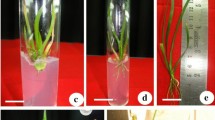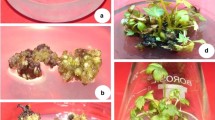Abstract
Acorus calamus L. (family-Acoraceae) is commonly known as ‘Sweet Flag’ which grows naturally in marshy land, shallow water and the edges of the pond. In recent years, there is a growing demand of this plant due to its multidimensional implications including food, cosmetics and pharmaceuticals. In the present study, an efficient and rapid in vitro regeneration system along with higher accumulation of secondary metabolites has been developed for A. calamus. The rhizome bud explant cultured on Murashige and Skoog’s medium supplemented with a combination of BAP (3.0 mg/l) and IAA (1.0 mg/l) resulted in the production of maximum numbers of shoots (11.3 ± 0.4). Microshoots were transferred to MS medium supplemented with various concentrations and combinations of auxins for in vitro rooting. The maximum contents of total phenolics, flavonoids and higher antioxidant properties were reported in the rhizomes of tissue culture raised plants as compared to field grown ones. Methanolic and acetone extract of rhizomes of micropropagated plants showed slightly elevated antibacterial activity against five bacterial pathogens. The current findings indicated that, the phytochemicals together with the bioactivity of Sweet Flag is significantly high in the tissue culture derived plantlets.


Similar content being viewed by others
References
Ahmed MB, Ahmed S, Salahin M, Sultana R, Khatun M, Razvy MA, Hannan MM, Islam R, Hossain MM (2007) Standardization of a suitable protocol for in vitro clonal propagation of Acorus calamus L. an important medicinal plant in Bangladesh. Am-Euras J Sci Res 2(2):136–140
Altaf A, Shashidhara S, Rajasekharan PE, Hareesh Kumar V, Honnesh NH (2010) In vitro regeneration of Acorus calamus—an important medicinal plant. J Curr Pharm Res 2(1):36–39
Amoo SO, Van Staden J (2012) Influence of plant growth regulators on shoot proliferation and secondary metabolite production in micropropagated Huernia hystrix. Plant Cell Tiss Org Cult 112(2):249–256
Asha Devi S, Ganjewala D (2011) Antioxidant activities of methanolic extracts of Sweet-flag (Acorus calamus) leaves and rhizomes. J Herbs Spices Med Plants 17:1–11
Bahukhandi A, Rawat S, Bhatt ID, Rawal RS (2013) Influence of solvent types and source of collection on total phenolic content and antioxidant activities of Acorus calamus L. Natl Acad Sci Lett 36(1):93–99
Balyan U, Verma SP, Sakrar B (2019) Phenolic compounds from Syzygium cumini (L.) Skeels leaves: extraction and membrane purification. J Appl Res Med Aromat Plants 12:43–58
Benzie IF, Strain JJ (1996) Ferric reducing ability of plasma (FRAP) as a measure of antioxidant power: the FRAP assay. Ann Biochem 239:70–76
Brand-Williams W, Cuvelier ME, Berset C (1995) Use of a free radical method to evaluate antioxidant activity. LWT Food Sci Technol 28:25–30
Chandra D, Prasad K (2017) Phytochemicals of Acorus calamus (Sweet Flag). J Med Plants Stud 5(5):277–281
Chang C, Yang M, Wen H, Chern J (2002) Estimation of total flavonoid content in propolis by two complementary colorimetric methods. J Food Drug Anal 10:178–182
Chaturvedi M, Chaturvedi AK (2017) Acorus calamus: a divine drug for the human being. Imp J Interdiscip Res 3(1):1499–1503
Chavan JJ, Gaikwad NB, Yadav SR (2013a) High multiplication frequency and genetic stability analysis of Ceropegia panchganiensis, a threatened ornamental plant of Western Ghats: Conservation implications. Sci Hortic 161:134–142
Chavan JJ, Gaikwad NB, Kshirsagar PR, Dixit GB (2013b) Total phenolics, flavonoids and antioxidant properties of three Ceropegia species from Western Ghats of India. S Afr J Bot 88:273–277
Chavan JJ, Jagtap UB, Gaikwad NB, Dixit GB, Bapat VA (2013c) Total phenolics, flavonoids and antioxidant activity of Saptarangi (Salacia chinensis L.) fruit pulp. J Plant Biochem Biotechnol 22(4):409–413
Chavan JJ, Nalawade AS, Gaikwad NB, Gurav RV, Dixit GB, Yadav SR (2014a) An efficient in vitro regeneration of Ceropegia noorjahaniae: an endemic and critically endangered medicinal herbof the Western Ghats. Physiol Mol Biol Plants 20(3):405–410
Chavan JJ, Gaikwad NB, Umdale SD, Kshirsagar PR, Bhat KV, Yadav SR (2014b) Efficiency of direct and indirect shoot organogenesis, molecular profiling, secondary metabolite production and antioxidant activity of micropropagated Ceropegia santapaui. Plant Growth Regulat 72:1–15
Devaki M, Nirupama R, Nirupama M, Yajurvedi HN (2016) Protective effect of rhizome extracts of the herb, vacha (Acorus calamus) against oxidative damage: an in vivo and in vitro study. Food Sci Hum Wellness 5(2):76–84
Hettiarachchi A, Fernando KKS, Jayasuriya AHM (1997) In vitro propagation of Wadakha (Acorus calamus L). J Natl Sci Counc Sri Lanka 25(3):151–157
Howes MR, Houghton PJ (2003) Plants used in Chinese and Indian traditional medicine for improvement of memory and cognitive function. Pharmacol Biochem Behav 75:513–527
Irshad S, Mahmood M, Perveen F (2012) In vitro antibacterial activities of three medicinal plants using agar well diffusion method. Res J Biol 2:1–8
Kim WJ, Hwang KH, Park DG, Kim TJ, Kim DW, Choi DK, Moon WK, Lee KH (2011) Major constituents and antimicrobial activity of Korean herb Acorus calamus. Nat Prod Res. 25(13):1278–1281
Kumar V, Singh R, Joshi V (2014) Antimicrobial activity of rhizome extract of Acorus calamus against different micro-organisms. Octa J Biosci 2(1):59–63
Marongiu B, Piras A, Porcedda S, Scorpciapino A (2005) Chemical composition of the essential oil and supercritical CO2 extract of Commiphora myrrha (Nees) Engl. and of Acorus calamus L. J Agric Food Chem 53:7939–7943
McGaw LJ, Jager AK, Van Staden J (2002) Isolation of β-asarone, an antibacterial and anthelmintic compound from Acorus calamus in South Africa. S Afr J Bot 68:31–35
Mukherjee PK, Kumar V, Mal M, Houghton PJ (2007) Acorus calamus: scientific validation of Ayurvedic tradition from natural resources. Pharm Biol 45(8):651–666
Murashige T, Skoog F (1962) A revised medium for rapid growth and bioassays with tobacco tissue culture. Physiol Plant 15:473–497
Ncube B, Ngunge VNP, Finnie JF, Van Staden J (2011) A comparative study of the antimicrobial and phytochemical properties between outdoor grown and micropropagated Tulbaghia violacea Harv. plants. J Ethnopharmacol 134(3):775–780
Palani S, Raja S, Praveen Kumar R, Venkadesan D, Devi K, Sivaraj A, Senthil Kumar B (2009) Therapeutic efficacy of antihepatotoxic and antioxidant activities of Acorus calamus on acetaminophen-induced toxicity in rat. Int J Integr Biol 7(1):39–43
Raina VK, Srivastava SK, Syamasunder KV (2003) Essential oil composition of Acorus calamus L. from the lower region of the Himalayas. Flavour Fragr J 18(1):18–20
Rani AS, Subhadra VV, Reddy VD (2000) In vitro propagation of Acorus calamus Linn.—a medicinal plant. Indian J Exp Biol 38:730–732
Sandhyarani N, Kishor R, Sharma GJ (2011) Clonal propagation of triploid Acorus calamus Linn. using dual phase culture system. J Crop Sci Biotechnol 14:85–95
Si MM, Lou JS, Zhou CX, Shen JN, Wu HH (2010) Insulin releasing and alpha-glucosidase inhibitory activity of ethyl acetate fraction of Acorus calamus in vitro and in vivo. J Ethnopharmacol 28:154–159
Singh KK, Prakash A (1994) Indigenous phytotherapy among the Gond tribes of Uttar Pradesh, India. Ethnobot 6:37–41
Singh R, Sharma PK, Malviya R (2011) Pharmacological properties and Ayurvedic value of Indian Buch plant (Acorus calamus): a short review. Adv Biol Res 5(3):145–154
Singleton VL, Rossi JA (1965) Colorimetry of total phenolics with phosphor-molybdic phosphotungstic acid reagents. Am J Enol Vitic 16:144–158
Verma S, Singh N (2012) In vitro mass multiplication of Acorus calamus L.—an endangered medicinal plant. Am-Eurasian J Agric Environ Sci 12(11):1514–1521
Acknowledgements
Rashtriya Uchchtar Shiksha Abhiyan (RUSA), Ministry of Human Resource Development (MHRD), Govt. of India is gratefully acknowledged for instrumentation facilities created under Component 8. Authors are indebted to the Principal, Yashavantrao Chavan Institute of Science, Satara (Autonomous) for providing necessary laboratory facilities.
Author information
Authors and Affiliations
Corresponding author
Additional information
Publisher's Note
Springer Nature remains neutral with regard to jurisdictional claims in published maps and institutional affiliations.
Rights and permissions
About this article
Cite this article
Babar, P.S., Deshmukh, A.V., Salunkhe, S.S. et al. Micropropagation, polyphenol content and biological properties of Sweet Flag (Acorus calamus): a potent medicinal and aromatic herb. Vegetos 33, 296–303 (2020). https://doi.org/10.1007/s42535-020-00107-8
Received:
Revised:
Accepted:
Published:
Issue Date:
DOI: https://doi.org/10.1007/s42535-020-00107-8




